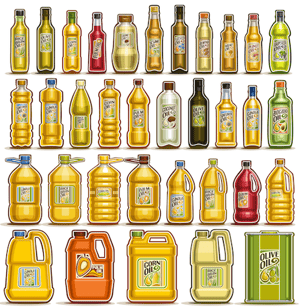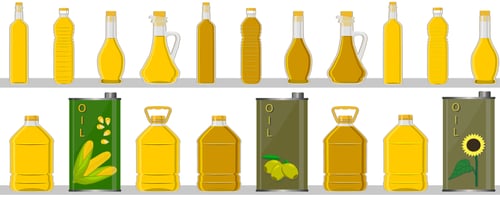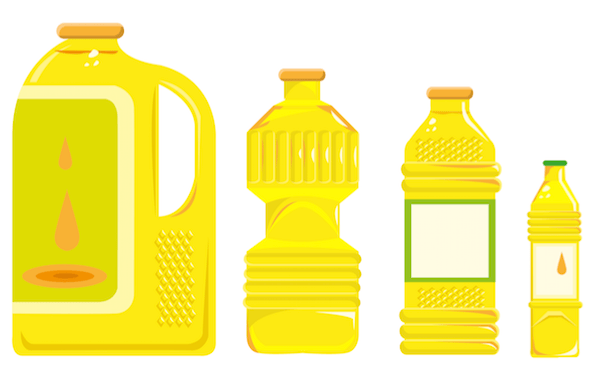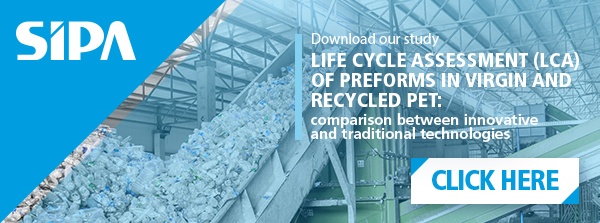
The choice of packaging plays a strategic role for all products.
Amongst these, the containers for food products are subject to specific norms and requisites to ensure that the content remains unaltered.
In this article we will look at this issue relative to edible oil.
Edible oil bottle packaging: oxidative reactions of oil in the presence of light
Oil is a food that requires specific protection to prevent oxidative reactions that could alter its quality.
The oxidative stability of edible oils is the resistance to oxidation during the production process and storage. This stability is an important indicator to determine the quality and shelf-lfe of the oil because low-molecular weight off-flavour compounds are formed.
Different chemical mechanisms, such as autoxidation and photosensitized oxidation, are responsible for the oxidation.
The oxidation of edible oils is influenced by the input of:
- Energy such as light or heat
- The composition of fatty acids
- Type of oxygen
- Minor components such as metals, pigments, phospholipids, free fatty acids mono and diglycerides
- Thermal oxidated compounds
- Antioxidants
READ ALSO: "PER recycled products: costs and methodologies for packaging"
The autoxidation of edible oils requires the formation of radicals of the fatty acids or acylglycerols. The formation of free radicals of fatty acids or acylglycerols can be accelerated by heat, metal catalysts and UV and visible light.
This is why the choice of packaging is so important. The development of a rancid taste in the oil is caused by oxidative degradation, in which the presence of light accelerates the process.
In particular, extra virgin olive oil must be protected from light and UV rays to prevent the formation of radicals that cause oxidation and the decay of the properties of this oil. As such it is important that the containers are coloured (mainly green and amber) to ensure the proper shelf life.
On the contrary, edible oil from seeds does not require a specific protection from light and therefore the containers can be transparent.
Main characteristics for edible oil bottle packaging
These are the main characteristics for good edible oil packaging:
· Attractive: to strengthen identity and product visibility
· Lightness and strength: a ratio to guarantee the best mechanical resistance
· Ergonomics: the ideal shape to make holding easier
· Screening capacity: a light barrier particularly for extra virgin olive oil
READ ALSO: "Key characteristic of edible oil bottle packaging"
The use of cans for edible oil bottle packaging
Until recently cans and glass bottles were the main materials for bottling and conservation of edible oil.
The first came in 3 or 5 litres sizes. The quality of cans has improved over the years from when it has been created with a single metal, without any soldering.
Soldering is in fact the most critical aspect of this type of packaging. It promotes the development of corrosion and liberates iron in ionic form that catalyses the process of oxidative degradation of the oil after opening.
This problem is overcome by avoiding the soldering of different types of metals.
In addition, the re-use of the can is not advisable. The materials can corrode, releasing compounds (due to the migration of the molecules) that interact with the product and degrade the quality of the oil.
The use of glass
This issue is more complex with respect to glass, with standard formats of 1 and 0.75 litres.
Glass has been subject to progressive colourations because of the potential negative effects of light.
Over time the use of transparent glass has been abandoned especially in case of extra virgin olive oil and replaced with dark glass (green or brown) even if this type does not effectively shield from the effects of light.
The weak point are notoriously diverse: glass is in fact fragile and costly. There is also the issue of weight that has a significant impact on transport costs, as well its low resistance to mechanical damage.
PET as a packaging for oil
In recent years PET has become increasingly used for packaging edible oil.
When speaking of PET products we mean both the traditional versions and the more recent variations such as recycled rPET in pellets or in flakes.
There are various reasons for the increasing popularity of PET.
In the first instance, it is lighter than cans and glass for transport. Then there are other advantages.
The formats have also promoted widespread diffusion with standardised 5 and 10 litre sizes and others that go well beyond this (up to 25 litres).
The advantages of PET containers can be summarised as follows:
- Lightness: economical to produce and requires less energy for transport
- Safety: it does not shatter and cause risks if broken or damaged
- Convenient: as they are safe and light they are also convenient for the consumer who is on the go
- Resealable: suitable for multi-service packs
- Recyclable: it can be recycled so that the PET can be used a number of times
- Sustainable: an increasing number of plastic PET bottles are made from recycled PET
- Distinctive: it can be blown in different shapes so that brands can use it to create identity and promote drinks (25% of consumers are inclined to try new product packaging)
- Flexible: producers can move from one bottle shape or size to another, meaning high efficiency.







